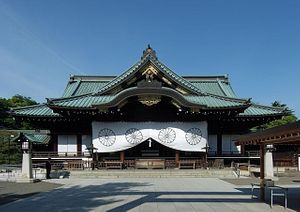A group of 73 politicians and 96 representatives in Japan visited the controversial Yasukuni Shrine in Tokyo on Tuesday. However, Shinzo Abe, the Japanese prime minister, was not seen in the vicinity of the controversial shrine. Abe’s absence at Yasukuni on Tuesday demonstrates that the Japanese prime minister is keenly aware that any diplomatic misstep could scuttle the fragile diplomatic rapprochement that is taking place in Northeast Asia between Japan, South Korea, and China after months of mistrust and distancing.
Abe last visited the Yasukuni shrine in December 2013, in a move that drew sharp criticism from Chinese and South Korean leaders. Yasukuni is a fixture of diplomatic controversy in East Asia where historical issues continue to limit the scope of international diplomacy. Fourteen Class-A war criminals found guilty by the International Military Tribunal for the Far East following World War II are commemorated at Yasukuni. The shrine has taken on particular significance with Abe’s tenure as Japan’s prime minister, as he is perceived as a revisionist when it comes to Imperial Japan’s wartime atrocities in East Asia.
Abe’s last major spat involving Yasukuni was last August, when he sent a note to a ceremony honoring over a thousand World War II war criminals at the shrine. Yoshihide Suga, Abe’s chief cabinet secretary, noted that Abe did so in his capacity as the head of Japan’s ruling Liberal Democratic Party (LDP) and not as the prime minister of Japan. That incident did not lead to a major freeze in Tokyo’s relations with Seoul and Beijing. In fact, later that year, Japan and China began a still-ongoing process of diplomatic thawing after over 16 months of zero high-level diplomatic contact.
Despite Abe’s absence at Tuesday’s ceremony, for observers in Seoul and Beijing, the optics of scores of Japanese lawmakers marching into Yasukuni isn’t a reassuring sign. Abe might not have joined his colleagues in the Liberal Democratic Party, but the Party’s overarching dominance in the Japanese legislature means that the views of these 73 politicians and 93 representatives are ultimately representative of a widespread lack of historical remorse among the Japanese political elite.
Despite still persistent mistrust among Northeast Asia three largest powers, Abe, South Korean President Park Geun-hye, and Chinese Premier Li Keqiang are set to resume a long-stalled trilateral leaders summit either later this month or in early November. For Abe, the trilateral will be an important venue to set Japan’s bilateral relationships with both China and South Korea back into motion. Park and Abe met briefly on the sidelines of the UN General Assembly. Furthermore, during her U.S. state visit, Park noted that she saw a possibility for a bilateral meeting between her and Abe.
Meanwhile, a Xi-Abe bilateral looks more likely. Yang Jiechi, China’s state councilor, visited Japan last week for high-level political talks, as Shannon Tiezzi reported. Yang kept the rhetoric positive while in Japan, suggesting that both sides are invested in keeping a lid on their disagreements.
Given these trends, it’s unsurprising that Abe would refrain from visiting Yasukuni with others in his party.

































